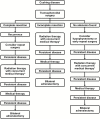Management of hormone-secreting pituitary adenomas
- PMID: 27543627
- PMCID: PMC5464431
- DOI: 10.1093/neuonc/now130
Management of hormone-secreting pituitary adenomas
Abstract
Pituitary adenomas are one of the most common primary central nervous system tumors and have an estimated prevalence of 17%. Approximately half of pituitary adenomas secrete distinct pituitary hormones (most often prolactin, growth hormone, or adrenocorticotropic hormone). While these tumors are histologically benign, they have potent endocrine effects that lead to significant morbidity and shortened lifespan. Because of their pathophysiologic endocrine secretion and anatomic location near critical neural/vascular structures, hormone-secreting pituitary adenomas require defined management paradigms that can include relief of mass effect and biochemical remission. Management of hormone-secreting pituitary adenomas involves a multidisciplinary approach that can incorporate surgical, medical, and/or radiation therapies. Early and effective treatment of hormone-secreting pituitary adenomas can reduce morbidity and mortality. Consequently, understanding clinical features as well as therapeutic options in the context of the specific biological features of each type of hormone-secreting pituitary adenoma is critical for optimal management.
Keywords: Cushing’s disease; acromegaly; management; pituitary adenoma; prolactinoma.
Published by Oxford University Press on behalf of the Society for Neuro-Oncology 2016. This work is written by (a) US Government employee(s) and is in the public domain in the US.
Figures



References
-
- Ezzat S, Asa SL, Couldwell WT, et al. The prevalence of pituitary adenomas. Cancer. 2004;101(3):613–619. - PubMed
-
- Tjörnstrand A, Gunnarsson K, Evert M, et al. The incidence rate of pituitary adenomas in western Sweden for the period 2001-2011. Eur J Endocrinol. 2014;171(4):519–526. - PubMed
-
- Raappana A, Koivukangas J, Ebeling T, Pirilä T. Incidence of pituitary adenomas in Northern Finland in 1992-2007. J Clin Endocrinol Metab. 2010;95(9):4268–4275. - PubMed
-
- Agustsson TT, Baldvinsdottir T, Jonasson JG, et al. The epidemiology of pituitary adenomas in Iceland, 1955–2012: a nationwide population-based study. Eur J Endocrinol. 2015;173(5):655–664. - PubMed
Publication types
MeSH terms
Substances
LinkOut - more resources
Full Text Sources
Other Literature Sources
Medical

